Products
ABS | HIPS | HDPE | LDPE | PA | PP | Filled Compound Plastic |
ABS (Acrylonitrile Butadiene Styrene)
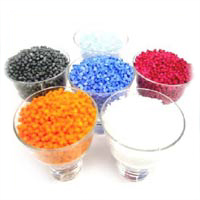 ABS is extensively used in the manufacture of inexpensive, durable products. The durability of ABS has made it a primary material in the manufacture of products such as, computer housings, televisions and computer monitor housings, automobile components, etc. ABS is extensively used in the manufacture of inexpensive, durable products. The durability of ABS has made it a primary material in the manufacture of products such as, computer housings, televisions and computer monitor housings, automobile components, etc.
As virgin ABS is somewhat expensive, recycling ABS is economically very attractive. Recycled ABS can be blended with virgin material to produce products with lower cost while preserving the high quality.
ABS is recycled by first shredding used plastics to produce shredded plastics. After this step, metals and undesirable plastics are separated from the shredded plastics to produce separated plastics. This separation process is often accomplished by using a water system with different velocity water streams on top of each other. After the material composition of the separated plastics has been analysed, the recovered ABS can be blended with virgin ABS to produce a desirable recycled plastic. Back to top
HIPS (Polystyrene)
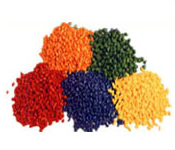 Polystyrene is a plastic material having many uses and is particularly useful, when in a foam form, as a material for making food containers. It is a significant constituent of municipal solid waste and is particularly prevalent in waste from fast food restaurants, cafeterias and similar food service establishments. Such establishments commonly use trays. containers and cups made of polystyrene foam (PSF). Also used in Radio housings, televisions and Refrigerator inner casings, disposable tumblers, ice cups Polystyrene is a plastic material having many uses and is particularly useful, when in a foam form, as a material for making food containers. It is a significant constituent of municipal solid waste and is particularly prevalent in waste from fast food restaurants, cafeterias and similar food service establishments. Such establishments commonly use trays. containers and cups made of polystyrene foam (PSF). Also used in Radio housings, televisions and Refrigerator inner casings, disposable tumblers, ice cups
Fast food restaurant and cafeteria waste in addition to containing large amounts of PSF also commonly comprises a large proportion of paper products (such as bags, cups and napkins), wax-coated paper products, condiment containers, plastic eating utensils and food morsels.
Recycled polystyrene foam can be used to manufacture a wide variety of products such as plant pots, plastic desk organizers, foam construction insulation etc. and is therefore, a valuable product. Further, polystyrene foam, like most plastic, takes a very long time to degrade when placed in landfills. Therefore, it is desirable to recycle polystyrene foam to reduce the amount of such plastic in municipal landfills.
Polystyrene can be recycled by first reducing it's size through a melting process. After this the the material can be transported to a pelletitzing facility in order to produce PS (GPPS), HIPS, EPS etc. These pellets can be used alone or blended with virgin material for better material properties. If PS is mixed with other materials, such as paper, the waste PS will first have to go though an advanced process of separation. Currently research is being done to see whether such a process would be economically viable.
PHYSICAL PROPERTIES
Tensile Strength : 2.20 - 2.70 N/mm²
Notched Impact Strength : 10.0 - 20.0 Kj/m²
Thermal Coefficient of expansion : 80 x 10-6
Max Cont Use Temp : 60 - 80 oC
Density : 1.03 - 1.06 g/cm3 Back to top
HDPE
(High Density Polyethylene)
 PE is made in 2 main types: HDPE and LDPE. It is a polyolefine. LDPE is usually a soft plastic type. It is tough, though not very strong and has a reasonable impact resistance. Making PE stronger with glass fibre is not usual practice. PE has excellent isolation properties, making it suitable for electrical isolation. Furthermore, PE is resistant against acids, bases, saltsolutions, water, alcohol and oils. PE is made in 2 main types: HDPE and LDPE. It is a polyolefine. LDPE is usually a soft plastic type. It is tough, though not very strong and has a reasonable impact resistance. Making PE stronger with glass fibre is not usual practice. PE has excellent isolation properties, making it suitable for electrical isolation. Furthermore, PE is resistant against acids, bases, saltsolutions, water, alcohol and oils.
HDPE can be used until 105 degrees celsius and becomes breakable at minus 50 degrees celcius. 45% of all HDPE are casted into various products such as buckets, crates etc. 40% is being blowmoulded into containers or bottles. These bottles are suitable for carrying various liquids except for drink which contain carbon dioxide. The reason for this is that HDPE bottles are permeable for gasses which will cause the carbon dioxide to slip out.
The recycling process of HDPE bottles starts by breaking apart the bales and grinding the bottles into small flakes. Often the bottles have been separated by colour beforehand. These flakes are then washed and floated to remove any heavy (sinkable) contaminants. This cleaned flake is then dried in a stream of hot air and may be boxed and sold in that form. More sophisticated plastic plants may reheat these flakes, add pigment to change the color and run the material through a pelletizer. This equipment forms little beads of plastic that can then be reused in injection molding presses to create new products.
Some common end uses for recycled HDPE are plastic pipes, lumber, flower pots, trash cans, or formed back into non food application bottles.Back to top
LDPE
(Low Density Polyethylene)
PE is made in 2 main types: HDPE and LDPE. It is a polyolefine. LDPE is usually a soft plastic type. It is tough, though not very strong and has a reasonable impact resistance. Making PE stronger with glass fibre is not usual practice. PE has excellent isolation properties, making it suitable for electrical isolation. Furthermore, PE is resistant against acids, bases, saltsolutions, water, alcohol and oils.
LDPE can be used up to 80-95 degrees celcius and becomes breakable at -50. About 75% of all PE is manufactured to LDPE, which is mainly used for sheets or film (bags, packing material etc.).
Waste LDPE requires special grinders to handle the thin films. The films can be either washed and repelletised, or used directly to make new products. The newly created LDPE pellets can be used alone, or mixed with virgin material for better properties of the end-product. Manufacturers use recovered LDPE to manufacture a variety of products including irrigation pipe, rubbish bags, black film and sheeting for the agricultural and building industries, and cable cover for the electrical industry.
Recently, new techniques have come available to be able to sort LDPE film better, and to be able to clean dirty films, such as agricultural LDPE film.Back to top
PA
(Polyamide)
PA, also known as Nylon, beholds a large group of polymers with various characteristics. The polymer is created through a condensationreaction of an acid-group with an amino-group. To be able to identify the different types of PA, the number of A-atoms of the monomers is put behind the name. Examples are PA 6, PA 6.6, PA 6.10, PA 11 and PA 12.
Uncoloured, PA is looking milkywhite, non-transparent. It can be easily coloured in about every colour. Polyamide has good mechanica characteristics, is though, does not wear ‘n tear easily and is very suitable for machinery parts. PA is restistant to gasoline, oil, fat, alcohol, weak bases and has excellent performance against aging. A big disadvantage of PA is its sensitivity for moisture.
A lot of PA 6 and PA 6.6 is used to produce carpets. As there is a lot of carpetwaste worldwide, a lot can be gained in recycling this material and extracting the PA. Various methods are being tested to see whether carpet recycling can be a viable business. This is tried out by companies such as DuPont and Polyamid 2000.
The recycling process of polyamide is dependant on the shape and previous use of the original product. Usually items which carry the same colour will be kept together in order to make them more suitable for the end-product. White and light coloured material is most widely applicable as it can be coloured into any other colour. The scrap PA material is first shreddered into little pieces, after which it is washed in a washing tank. After this the cleaned materials are passed through an extrusion and pelletization process that produces pellets. These pellets can be directly used as raw material to produce new PA products. Often the recycled pellets are blended with virgin material for better material properties.Back to top
PP
(Polypropylene)
Polypropylene, also known as polypropene, shares a lot of characteristics with hard polyethylene. As a virgin material it is generally more expensive than PE.
PP is one of the lightest plastics around, with a density of 0,91 grams per kubic centimeter. The material is very resistant to temperature (resistant up to 110 degrees celcius), is almost unbreakable and has some of the good characeristics of both PS and PE. It is very resistant again fatigue from bending because of which it is very suitable for simple hinges. PP becomes breakable at temperatures below 0 degrees celcius.
PP is used commonly in technical applyances for which it is suitable due to it’s shape stiffness. Though polypropylene shares charasteristics with PE, it is not resistant to gasoline. Due to it’s resistance to hot steam sterilization, PP is also commonly used in medical equipment. PP can be modified by adding 30% glass fibre.
Recycling PP is similar to recycling any plastic, the materials are collated, sorted and sold to a re-manufacturer. The re-manufacturers then chip or shred the plastic, wash it, melt it and re-mound it into new items (generally after mixing the melted plastic with plastic from new oil or gas). New items that are made from PP include some witches hats (traffic cones), compost bins, worm farms, garden furniture, garden edging and other plastic products.Back to top
Filled Compound Plastic Raw Material
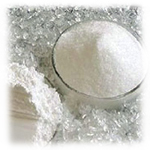 We are the finest quality filled compound plastic raw material manufacturers ensuring finest manufacturing standards as they are made by using the most high-tech machines in the industry. The raw material we produce is available in different colors as per the specification of the client. The raw materials are tested at each manufacturing stage and then considered to be delivered. Our filled compound plastic raw materials exhibit strength, high flow and are thermally resistant & is widely used in the Automobile industry. These are available in the following standards: We are the finest quality filled compound plastic raw material manufacturers ensuring finest manufacturing standards as they are made by using the most high-tech machines in the industry. The raw material we produce is available in different colors as per the specification of the client. The raw materials are tested at each manufacturing stage and then considered to be delivered. Our filled compound plastic raw materials exhibit strength, high flow and are thermally resistant & is widely used in the Automobile industry. These are available in the following standards:
Glass Filled
Mica Filled
Calcium Filled
Mineral Filled
Talc Filled Back to top
COIR FIBER
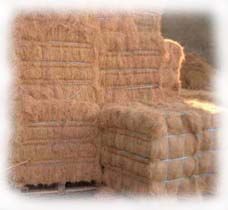
|
Coir fibre is obtained
from fully ripe brown coconut husks by wet or dry
milling. The process involves soaking brown coconut
husks up to one month in fresh water, and combing on a
pair of rotating spiked drums.
Dirt and other rubbish are removed from the coir fiber
and then dried and packed into bales. Brown coir fiber
is used mainly for filling mattresses and upholstery,
for manufacture of needle felt pads used in
innerspring mattresses, and in drainage filters with
perforated pipes. |
|
Product
Specifications
Color
: Brown & Golden Brown
Fiber Length : 10 – 20 cms
Impurities
: Below 3 %
Package
:110-120 Kg bales
Load Ability :20 Tones in
40'HC FCL
Moisture
:Less than 15% Back to top
COIR PITH BRICKS
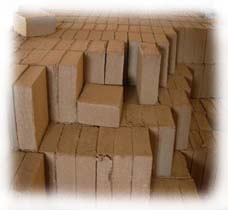
|
Coco Peat is a totally organic
growing medium that maintains the soil hale and
hearty in a natural way, when compared with other
growing medium coco peat has many advantages such
as larger oxygen capacity. Coir pith enhances the
nutrient carrying capacity of plants.
Coir pith revitalizes your plants; it induces
uniformity in growth by enhancing water retention
and microbial activity. It has good water holding
ability. Coco peat is also rich in root
stimulating hormones. The anti-fungal properties
of coco peat protect your plants from root
diseases. It acts as a top dressing that helps
maintain moisture and reconditions the soil. |
Sustainable agriculture practices such as
this creates a healthy perfect loop from table to
earth. This natural spongy coir industry by-product is
a perfect organic growing medium for fruits,
vegetables and flowers.
Features
of Coco peat compost
Contains - Nitrogen, Phosphorus and Potassium,
Calcium, Copper and magnesium
Contains natural enzymes
Good water holding capacity
Improves aeration
Enhances strong heap root system
Stimulates production of phytohormones
Ideal pH level — 5.6 to 6.4 Eco-Friendly
Product
Specifications
Moisture 15% max
Sand 3 % max
EC <1 MS
Unit Weight ( +/-3%) 5 kg
Dimension ( +/-2cm) 30x30x12 cm
Loading ability 20 to 21 MT in 40' HC FCL Packing
Palatalized –Stretch Back to top
|
|